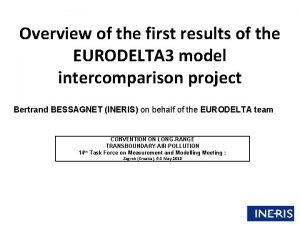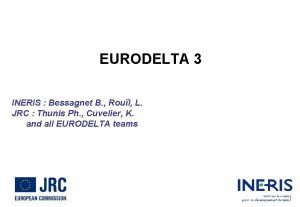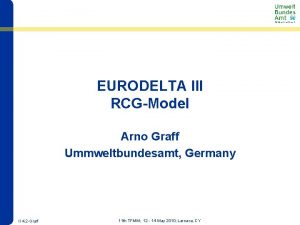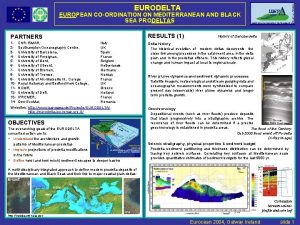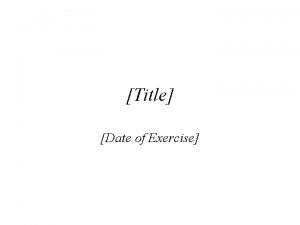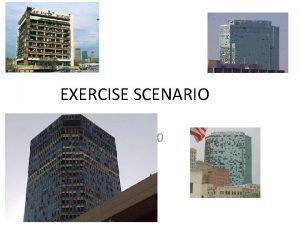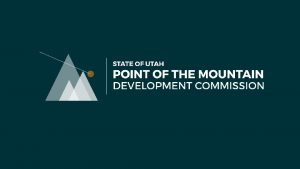Main results of the Eurodelta 3 exercise Phase




















- Slides: 20

Main results of the Eurodelta 3 exercise Phase I on criteria pollutants Bertrand BESSAGNET (INERIS) on behalf of the EURODELTA team CONVENTION ON LONG-RANGE TRANSBOUNDARY AIR POLLUTION 16 th Task Force on Measurement and Modelling Meeting: 5 - 8 May 2015 in Krakow

B. Bessagnet, A. Colette, F. Meleux, L. Rouïl, A. Ung, F. Couvidat (INERIS) P. Thunis (EC JRC) C. Cuvelier (ex. EC JRC) S. Tsyro (Met Norway) R. Stern (FUB) A. Manders, R. Kranenburg (TNO) A. Aulinger, J. Bieser (HZG) M. Mircea, G. Briganti, A. Cappelletti (ENEA) G. Calori, S. Finardi, C. Silibello (ARIANET) G. Ciarelli, S. Aksoyoglu, A. Prévot (PSI) M. -T. Pay, J. M. Baldasano (BSC) M. García Vivanco, J. L. Garrido, I. Palomino and F. Martín (CIEMAT) G. Pirovano (RSE) P. Roberts, L. Gonzalez (CONCAWE) L. White (AERIS EUROPE) L. Menut (LMD, IPSL, CNRS) J. -C. Dupont (IPSL, CNRS) C. Carnevale, A. Pederzoli (UNBS)

The Eurodelta III exercize • Two phases: 1. Simulation of intensive measurement campaigns + EMEP measurements • • 1 Jun - 30 Jun 2006 (Summer) 8 Jan - 4 Feb 2007 (winter) 17 Sep - 15 Oct 2008 (fall) 25 Feb - 26 Mar 2009 (winter) 2. Retrospective analysis (2010, 1999, 1990) Full trend analysis • Common inputs for models : meteorology (IFS except for CMAQ and RCG), emissions (EC 4 MACS dataset), boundary conditions (MACC), domain (except CMAQ) • Iterative process, with several improvements performed by the modelling teams • One report written for the 2009 campaign and 5 publications ongoing for all campaigns

Teams & models Teams Model acronym in Simulated campaigns this study PSI/RSE CAMx CAMX 2006, 2007, 2008, 2009 INERIS CHIMERE CHIM 2006, 2007, 2008, 2009 HZG CMAQ 2006, 2007, 2008, 2009 MSC-W - Met. NO EMEP 2006, 2007, 2008, 2009 TNO LOTOS-EUROS LOTO 2006, 2007, 2008, 2009 ENEA MINNI 2006, 2007, 2008, 2009 FUB RCG 2008, 2009 RCG : different meteorology CMAQ : different meteorology and domain ENS=CAMX, CHIM, EMEP, LOTO, MINNI

Wind speed (U 10) and Temperature (T 2 M) ~1 million data

Planetary Boundary Layer (PBL) • • Various ways to calculate the PBL Very different PBL over the oceans Negative biases for all models except for CMAQ (compared to PBL at 12: 00) The most negative biases are observed for MINNI on average in Europe

Diurnal cycle at SIRTA (PBL, U 10) – CAMX versus Obs • Results for the 2009 campaign • Positive bias particularly important early in the morning for the wind speed • Important negative bias for the PBL during the night • Shift of three hours for the collapse of the PBL

Ozone • Strong impact of boundary conditions • RMSE close to 20 µg m-3 • CMAQ gives the lowest correlations for all campaigns • Negative bias at several medium altitude / shore sites • ENS (without RCG and CMAQ)

NO 2 • Similar correlations (0. 6 -0. 7) • CMAQ overestimates the concentrations • CAMX systematically underestimate the concentrations • CMAQ & CHIMERE overshoot at night, all models underestimate in the afternoon

• The coefficient of variation is the lowest over emission areas but very high in remote areas like over the oceans • Very different way to simulate the SO 2 chemistry and deposition processes in the models. • Diurnal cycle? ? !! SO 2

PM 10 • In general, the models underestimate, MINNI and EMEP have the lowest underestimations (PBL effect? ) • Flat diurnal cycle in the observations, slight decrease in the afternoon for the models

PM 10 Left column: Average PM 10 concentrations (µg m-3) of the “ensemble” (ENS) for the 2009 campaign with corresponding observations (coloured dots). Right column: coefficient of variation of models (no unit) constituting the ensemble with corresponding normalized root mean square errors of the “ensemble” (coloured dots).

PM 2. 5 • General underestimations particularly in winter • Correlations between 0. 5 and 0. 7 • Flat profile with a slight increase for the 2006 campaign in the observations – Models see a decrease in the afternoon

PM 2. 5 diurnal cycles

Nitrate & OM Coarse nitrate? Underestimation of higest values Robustness of SIA chemistry Systematic underestimation Lack of emissions – SOA production

Diurnal cycles of nitrates & ammonium

Some conclusions • Important role of boundary conditions on O 3 mean values • The ensemble gives a good picture of PM patterns in Europe with a systematic underestimation • Diurnal cycles show a large impact of the PBL diurnal evolution • Quality of meteorological data • Models underestimate the PBL, for some of them this undertimation could be very important during the night • Wind speed is overestimated on average (problem for low wind speed conditions) • There is a lack of chemical production in the afternoon for PM • The highest PM values are underestimated (role of dust and OM) – lack of sources (condensable organic species) • Some models can be better for one species but this can hide compensation effects on some PM components ( next presentation)


Ensemble of CO – Coefficient of variation • Low coefficient of variation far from the sources • Vertical mixing is certainly the most influencial variable affecting the dilution/mixing of sources

PM 2. 5 Left column: Average PM 2. 5 concentrations (µg m-3) of the “ensemble” (ENS) for the 2009 campaign with corresponding observations (coloured dots). Right column: coefficient of variation of models (no unit) constituting the ensemble with corresponding normalized root mean square errors of the “ensemble” (coloured dots).
 Normal phase vs reverse phase chromatography
Normal phase vs reverse phase chromatography Hplc reverse phase vs normal phase
Hplc reverse phase vs normal phase Mobile phase and stationary phase
Mobile phase and stationary phase Chromatography definition
Chromatography definition Normal phase vs reverse phase chromatography
Normal phase vs reverse phase chromatography Power formula three phase
Power formula three phase Chromatography mobile phase and stationary phase
Chromatography mobile phase and stationary phase Phase to phase voltage
Phase to phase voltage Broad phase vs narrow phase
Broad phase vs narrow phase Be going to
Be going to What is the central idea of this passage?
What is the central idea of this passage? Void main int main
Void main int main Hình ảnh bộ gõ cơ thể búng tay
Hình ảnh bộ gõ cơ thể búng tay Bổ thể
Bổ thể Tỉ lệ cơ thể trẻ em
Tỉ lệ cơ thể trẻ em Voi kéo gỗ như thế nào
Voi kéo gỗ như thế nào Tư thế worm breton
Tư thế worm breton Hát lên người ơi
Hát lên người ơi Kể tên các môn thể thao
Kể tên các môn thể thao Thế nào là hệ số cao nhất
Thế nào là hệ số cao nhất




















